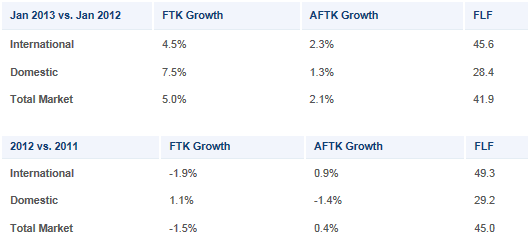Signs of stabilization as air cargo grows in January
- Like
- Digg
- Del
- Tumblr
- VKontakte
- Buffer
- Love This
- Odnoklassniki
- Meneame
- Blogger
- Amazon
- Yahoo Mail
- Gmail
- AOL
- Newsvine
- HackerNews
- Evernote
- MySpace
- Mail.ru
- Viadeo
- Line
- Comments
- Yummly
- SMS
- Viber
- Telegram
- Subscribe
- Skype
- Facebook Messenger
- Kakao
- LiveJournal
- Yammer
- Edgar
- Fintel
- Mix
- Instapaper
- Copy Link
Posted: 4 March 2013 | IATA | No comments yet
IATA released global air freight demand statistics for January 2013…


The International Air Transport Association (IATA) released global air freight demand statistics for January 2013 showing a stabilization of air freight markets on the back of encouraging growth towards the end of 2012. Compared to the previous year, demand for air freight was apparently very strong, with a rise of 5.0%. However the rise was from an exceptionally low base, caused by the timing of Chinese New Year, which occurred in February this year, skewing year-on-year comparisons as many Asian factories close and last year the holiday period occurred in January. Compared to the level of Freight Tonne Kilometers (FTK) in December, air freight volumes in January were 0.9% lower. Year-on-year, capacity expanded by 2.1% and the global load factor stood at 41.9%.
“The air freight business is showing some encouraging signs. But it’s too early to be overly optimistic. While the decline has stopped, overall volumes are still below the levels of 2010 and 2011. Load factors are low. And the global economy is fragile. Our forecast remains for modest demand growth of 1.4%. But with weak load factors, yields are going to continue to be under severe downward pressure,” said Tony Tyler, IATA’s Director General and CEO.


Regional Highlights
- Asia-Pacific carriers, which represent some 39.2% of global air cargo, saw year-on-year demand growth of 7.1% while capacity was down 0.4%. Adjusting for the effect of Chinese New Year, it is estimated that the region’s carriers saw demand growth of about 3.0%. The region’s airlines have captured about 60% of the growth in FTK volumes seen in January compared to October. This has been led by the acceleration in the Chinese economy and with export-dependent economies like South Korea and Chinese Taipei experiencing stronger global demand.
- North American airlines saw a modest 0.6% growth compared to January 2012, while capacity was trimmed by 1.0%. US consumers are looking more positive about their economic prospects, and North American airlines have contributed 15% of the global FTK increase observed in January compared to October.
- European airlines reported demand growth of 1.2% year-on-year, which was half the 2.4% growth in capacity. Persistent economic weakness in the Eurozone, which is a major market for air freighted consumer goods, is dampening global world trade growth, and will limit the growth in air freight volumes in 2013.
- Middle Eastern airlines continued to be the fastest-growing, reporting a demand increase of 16.3% over January 2012. This was ahead of a 12.4% capacity expansion. The region’s airlines continue to benefit from route and capacity expansion into rapidly growing economies in West Africa and Asia.
- Latin American airlines were the only regional grouping to report a fall in demand, with a 1.6% decline on the previous year. That was against a 10.2% increase in capacity. Latin American airlines have been adding air freight capacity to seize the opportunities of solid trade growth in many regional economies. This potential is also attracting airlines from other parts of the world which has led to very stiff competition.
- African airlines reported a demand increase of 3.7% while capacity expanded by 13.9%. The region’s carriers benefitted from strong economic growth, particularly in West Africa.
Priorities for 2013
On 12 March the world’s air cargo leaders will gather in Doha, Qatar for the World Cargo Symposium. “The challenge is sustainable business growth. Headwinds presented by the fragile global economic situation are strong. But if governments and all the players of the value chain are aligned, there is much that can be done to improve the competitiveness of the global air cargo industry. Infrastructure, technology, environment, security and industry processes are among the symposium’s topics,” said Tyler.
“Air cargo is important to the global economy and everyday life. By value, nearly a third of goods traded internationally are shipped by air. Jobs and economic opportunities are created by connecting goods to markets. And lives are enriched by the global trade of products and services which is made possible by air connectivity. Supporting the sector’s success is in everybody’s interest,” said Tyler.
View full January air freight results (pdf)













